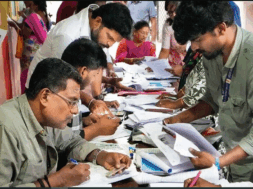
Covid-19: ‘Omicron may infect 3bn by Feb’22; 3rd wave in India in 2 months’
Virendra Pandit
New Delhi: In grim warnings, researchers have predicted that the Omicron variant of the coronavirus disease, now reported from over 100 countries, may cause around three billion infections across the world in the next two months, and India may also witness the third wave of the pandemic peaking in February 2022.
The global population of humans is 7.9 billion.
If true, that would mean more infections globally than were seen in the first two years of the pandemic (2.78 billion), according to the media reports on Friday.
In its latest report released on Thursday, the Institute for Health Metrics and Evaluation (IHME), an independent global health research center at the University of Washington, said that peak transmissions could be in mid-January with over 35 million infections being registered in a day worldwide.
This is three times the peak in April 2021, caused by the Delta variant of the coronavirus, the report said.
However, the IHME said there is huge uncertainty regarding the severity of Omicron.
The rate of infection-caused hospitalization because of the Omicron variant may remain 90 to 96 percent lower than what they saw in the case of the Delta variant. The infection-fatality rate has also, so far, been lower than with previous strains.
Increasing the use of masks up to 80 percent will have a huge effect on cases, hospitalizations, and deaths. “More rapid and extensive delivery of third doses of vaccine will also reduce the burden of hospitalization and death. The unvaccinated and never infected are at greatest risk,” the IHME report added.
Offices and schools will also have to re-evaluate their approach to testing and quarantine, given the rapid spread of the new variant, which was first detected in South Africa in November and then categorized by the World Health Organization (WHO) as a “Variant of Concern” (VOC).
“Going forward, tracking hospitalizations rather than reported cases will be a more relevant measure for local action than case counts,” the report said.
Earlier, the WHO had said more data was needed to understand the severity of the variant and how the severity was impacted by vaccination and pre-existing immunity.
So far, they have detected Omicron in over 100 countries. As the cases are spiking globally, especially in the United States and the United Kingdom, the WHO warned that healthcare systems may become quickly overwhelmed in many places.
Meanwhile, researchers at the Indian Institute of Technology-Kanpur have predicted in a project report that the third wave of Covid-19, which Omicron may trigger, is likely to peak in India by February 3, 2022.
“Following the trends around the world, this project report forecasts India’s third wave to start around mid-December and peak at the beginning of February,” the report, published in online preprint server MedRxiv, said. The team used a statistical tool called the Gaussian Mixture model to predict the third wave in India.
The researchers used the data of the first and second waves in India, and the current rise in cases triggered by Omicron in various countries, to predict a possible third wave in the country, the media reported.
The study “suggests the cases reach peak value after 735 days from our initial observation date, which is January 30, 2020, when India reported its first official case of Covid-19. So, the cases start rising around December 15, 2021, and the peak of the third wave will occur on Thursday, February 3, 2022.”
They said the key question after the first and second waves of Covid-19 was ‘will the third wave also arrive and, if yes, then when. To unravel the puzzle, the team used a statistical method based on the fitting of a mixture of Gaussian distributions.
“After plotting the daily cases per million of all other countries and matching the graphs with India, the top 10 countries with the best match were chosen as a training dataset.
The top 10 countries are US, UK, Germany, France, South Africa, Russia, Israel, Spain, Zambia, and Zimbabwe. Zambia and Zimbabwe are the closest matching countries for which the daily cases data follow very similar patterns to India’s,” the researchers said.














